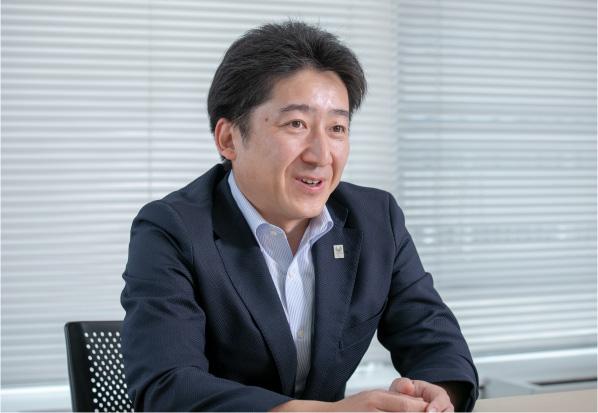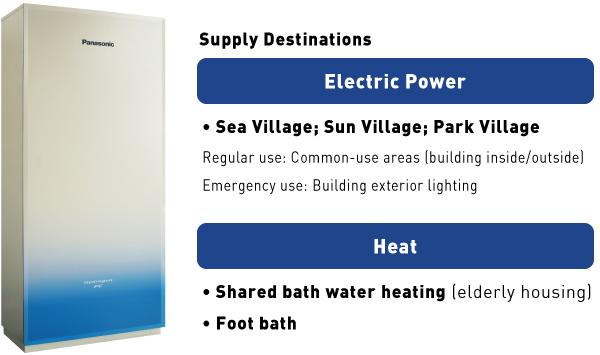
HARUMI FLAG, is a residential compound being built on 18 hectares of land stretching out in Harumi, Tokyo. It will be a hydrogen powered town. That unique energy system will cement its role as a testimony to the future. The power system producing hydrogen-generated electricity to cover an entire residential area is the first practical application of its kind ever operated in Japan. This is the story of the challenges and rewards of the pioneers who made this a reality. They worked tirelessly together with the government to set legal requirements for hydrogen power system operators, as well as determining specifications for pipelines. Let's walk through this hydrogen town of the future.
A summary of this article
- Harumi Flag is originally being built as the Olympic Village for the Tokyo 2020 Games. As Japan's first full-scale hydrogen infrastructure, it will leave a legacy as a "smart town" to future generations. Six energy companies are on board for the construction of the infrastructure.
- Energy sector companies are responsible for assigned works, e.g., building/running a hydrogen station, pipeline laying, hydrogen fuel cell generator development.
- Hydrogen fuel cell generator development has been assigned to Panasonic. Leveraging technologies achieved in EneFarm (residential fuel cell), performance has been tested at four domestic sites.
- Panasonic provides technologies for the effective "use" of hydrogen to support the hydrogen town project and plans to move ahead to develop technologies needed to "generate" and "store" hydrogen power.
A City with the First Full-Scale Hydrogen Infrastructure Japan Has Ever Seen
Japan has never seen a place like HARUMI FLAG, a town with a full-scale hydrogen infrastructure system. Located in Harumi, Tokyo, the transport nodal connecting urban and bay areas, the town is now under construction in a 18 hectare area. A total of 5,632 privately-owned/rental flats will be completed by 2024. A hydrogen station is slated to be built near the town. The work of laying underground pipelines to deliver hydrogen from the station to five residential blocks has already been completed. The pipelines will be connected to hydrogen fuel cell generators that will be installed in each block.

HARUMI FLAG after Completion - Bird's Eye View CG and Hydrogen Supply Conceptual Schematic
The original concept of a city with hydrogen power electricity came from the Tokyo Metropolitan government, the owner of the redevelopment project.
The government, in March 2016, announced its plans regarding the environment and sustainability, stating "initiatives to build a hydrogen society." It included the following goals: "double the hydrogen power generation and use by Tokyo 2020 Games" and "start operating a full-scale hydrogen supply system" for the Olympic Village. In the same month, "Residential Development for the Olympic Village after the Tokyo 2020 Games" was announced. It has three pillars: (1) Build a hydrogen supply station for Bus Rapid Transit (BRT) systems and fuel cell vehicles (FCVs); (2) Install next-generation fuel cells for common-use spaces and commercial buildings; and, (3) Install EneFarm (residential fuel cell) to all privately owned residences.
Takeshi Ikawa of the Tokyo Metropolitan government talked about the potential uses of hydrogen as a source of energy. "Hydrogen is a clean, zero-emission energy source. It emits only water upon combustion. With the capability of allowing for redundancy as an independent energy source in the event of a disaster, advance toward commercial viability affords great potential. I believe reusable hydrogen energy holds the trump card to creating a low carbon emission society."

Takeshi Ikawa
Director of Public Redevelopment
Urban Development Projects Division, Bureau of Urban Development of Tokyo Metropolitan Government
Through a public offering process, in July 2016, the Tokyo Metropolitan Government selected a corporate group represented by Tokyo Gas as a private development operator, which will provide support in moving towards developing practical uses for hydrogen energy. The metropolitan government also set up the Olympic Village Energy Committee composed of experts from outside to better review public and commercial viability of hydrogen use. The project called "Energy Infrastructure for the Olympic Village Area" came out from the framework in March 2017.
The project lists three elements to achieve its goals: (1) Self-sustained energy supply; (2) Life comfort with low emission; and (3) A model city of advanced sustainability. Mr. Ikawa said, "These represent our mindset. We have a mission here to pioneer in a true low-carbon society through this project."
April 2021, Hydrogen Fuel Cell Generator Will Become a Reality
As mentioned earlier, the hydrogen energy infrastructure for HARUMI FLAG involves the construction/installation of a hydrogen station, pipelines, and hydrogen fuel cell generators. Officially announced as a business operator, the corporate group represented by Tokyo Gas and with four (currently, six) private firms will run the energy business there.
JXTG Nippon Oil & Energy, a member of the group, is responsible for the construction and operation of the hydrogen station that will stand in a neighboring piece of land with an area of 4,800 m2, leased from Tokyo Metropolis. The company will supply hydrogen to the BRT transportation system and local bus service FCV fleet, both of which will connect urban and bay areas. It will also produce hydrogen within the station to be sent out to residential blocks via the pipelines buried under the streets.
Harumi Eco Energy Co., Ltd., a wholly-owned subsidiary of Tokyo Gas incorporated in October 2017, lays pipelines and distributes hydrogen to town blocks. It is the owner of all hydrogen fuel cell generators that will be installed in the residential blocks and lends them out to, e.g., town management unions.
Electricity and heat the hydrogen fuel cell generators produce will be used by the unions, i.e., consuming end. The supply coverage encompasses all four residential blocks in HARUMI FLAG. Heat will also be supplied to a condominium with a footbath lounge and another that has elderly housing with shared bathing facilities.
As a member of the energy sector corporate group, Panasonic is responsible for the supply of hydrogen fuel cell generators to each residential block. It plans to, by April 2021, bring out fuel cells capable of delivering power output of 5 kW and rated energy conversion efficiency (i.e., lower heating value, LHV) of 56%. Six fuel cells will combine to supply electricity, at a total power output of 30 kW to each residential neighborhood.
Panasonic has long been a pioneer in fuel cell technologies. Back in 1999, it started basic design and development of EneFarm, a residential fuel cell. It was later released to the market in 2009. Heading the company's smart energy business, Keishi Yamamoto said, "Ever since EneFarm was first placed on the market, numerous improvements have been added in terms of durability, dimensions, conversion efficiency, ease of installation, resilience, and cost. A decade-long accumulation of technology will help us pursue a higher energy conversion rate and extended durability in hydrogen fuel cell generators."

Keishi Yamamoto
Manager
Business Promotion Section, Corporate Planning Department, Smart Energy System Business Division
Appliances Company, Panasonic Corporation
The verification of new elements for improvements involves a number of tests on prototype safety and performance. For hydrogen fuel cell generators, performance test programs using one to three units are in place at: Yume Solar Kan Yamanashi, a solar power museum jointly built and operated in Kofu city, Yamanashi, by the local government and TEPCO; Shizuoka Hydrogen Town, a stationary hydrogen station owned by Shizuoka Gas for testing the viability of hydrogen power generation; Tsunashima Sustainable Smart Town (Tsunashima SST) in a former factory facility of Panasonic in Yokohama city; and Panasonic Kusatsu Factory.
Stabilizing the Energy Consumption for the Entire Town
A smaller profile has an advantage when it comes to hydrogen fuel cell generators used in urban areas. Dimensioning target is 900 x 500 x 1800 mm. Yoichiro Takagi of Mitsui Fudosan Residential, the representing company of the HARUMI FLAG private operator group, views it to be remarkably compact.
"It was hard to select the best player to come on board for the project of a smart hydrogen city. We are on the purchase side in terms of hydrogen fuel cell generators. Catalogs or purchase history are not the basis for the selection of suppliers. What is being developed? To what extent is the service coverage? These had to be factored in as our conversation encompassed the future of an entire city. Panasonic had pioneering technologies in its product line that would meet the requirements for installation in residential areas. And that was what we needed."

Yoichiro Takagi
Senior Project Manager
Tokyo Olympic and Paralympic Athletes' Village Department Promotion Group
Mitsui Fudosan Residential Co., Ltd.
Panasonic's latest EneFarm became the choice for home-use fuel cells for all flats to be built and sold by the private operator group. The home energy storage system and Panasonic's Home Energy Management System (HEMS) will work in combination to monitor and optimize power usage and consumption at each home.

The electricity, both generated by EneFarm (residential fuel cell) and purchased from a power company, is stored until use.
The heat produced during power generation can be used to heat the water needed for cooking, washing, or bathing water.
Hydrogen will be the primary source of electricity consumed in HARUMI FLAG, though, conventional grid-supplied electricity will also be available to augment the system. Solar generation and power storage systems will be seen in common-use areas of 21 high rises that are now under construction. Data from all these will be monitored by energy management systems designed to fit the size of organizing unions of town or block for leveled out power consumption.

EneFarm (residential fuel cell) cogeneration system for domestic use (ref image)
Mr. Takagi looks to the future. "Maison Energy Management System (MEMS) collects data on energy supply and consumption per residential block. The data is captured by the server for the area energy management that covers the entire town, and then is analyzed. Analysis results report the current trend of power consumption, predict peak demand, and help lower the reliance on conventional grid-supplied power and in turn reduce the cost for energy." In each residential block, Panasonic-made MEMS will keep an eye on data for better energy use.
A town powered by a full-scale hydrogen infrastructure - there has never been a place in Japan like HARUMI FLAG. It was not clear, during the planning phase of the energy infrastructure, which public sector, i.e., gas or power, would take on the hydrogen supply. Eventually, the Gas Utility Industry Law was selected to define regulatory requirements. That means that technical requirements for medium-pressure gas pipes apply to the pipelines to be laid underground.
Doing Something Never Been Tried Before Involves Much Examination and Many Discussions
With an eye on the need for safety and risk evaluation regarding hydrogen supply, the Ministry of Economy, Trade, and Industry (METI), the issuing authority of the Gas Utility Industry Law, formed a committee responsible for rating safety levels. The committee-approved specifications for hydrogen pipelines and the work of laying them require additional safeguards to those that apply to medium pressure gas conduit. Specifically, laying depth is to be no shallower than 120 cm and in order to protect them from damage they must be covered with a protective iron plate.
As is required for city gas operators, hydrogen supply involves the use of monitoring instruments, e.g., seismometers, pressure gauges, for ensured safety. Fumihiko Fukuchi from Tokyo Gas, also serving at Harumi Eco Energy explained, "Any abnormal reading detected at a sensor immediately triggers the hydrogen supply to be shut off at the hydrogen station."

Fumihiko Fukuchi
Manager
Energy Sales and Service Planning Dept., Energy Solutions Division
Tokyo Gas Co., Ltd.
As a hydrogen supplier, the hardest challenge was in determining each of these aspects from scratch. Mr. Fukuchi said, "The Gas Utility Industry Law is not designed to cover the business of pure hydrogen supply. Challenges arise in how to interpret the requirements stated in regulations to suit hydrogen and make them applicable for safety procedures of our own. We have done the toughest part, yet, new issues may arise when the hydrogen power system comes online."
What are the expectations for the hydrogen town?
"As renewable energy resources become more diverse, energy companies are now in the process of identifying which energy source turns out to be the most active contributor and how it aids bringing in a low carbon society. Hydrogen is among the promising candidates," Mr. Fukuchi added. "Hydrogen system would provide the bulk energy storage, and that's what makes it attractive. Hydrogen stored within the premises of HARUMI FLAG in large amounts for extended periods of time will secure the source of electricity the entire year even in the event of a disaster. Hydrogen fuel cell generators produce heat that has other applications, suitable for multi-purpose developments," said Mr. Takagi, as he viewed it from the perspective of a developer.
The HARUMI FLAG project will encourage the launch of more hydrogen towns home and abroad. And the hydrogen fuel cell generators of Panasonic endorse the initiative. It's time to move onto the next - from the technology of how to use hydrogen, to the technology to produce and store it.

Hydrogen fuel cell generator (PEFC) to be installed in each block intakes hydrogen for power generation.
- Reproduced from the website "Mirai-kotohajime," by courtesy of Nikkei Business Publications, Inc.
# # #
- Disclaimer:
- We would like to note that Panasonic Newsroom is not a place to address personal Customer Service issues. Even though this is not the forum, Panasonic is always eager to resolve your concerns. Our local customer services contacts can be found at Global Support or you can see our list of Social Media Accounts to find the right channel for your queries and concerns.
Related Links
Related News
- HARUMI FLAG, the City That Brings the Future to Today's Tokyo (Part 1 of 2) (Sep 5, 2019)
- The Challenge - Panasonic's Legacy for 2020 and Beyond (Aug 23, 2019)
- [Press Release] Panasonic to Commercialize Hydrogen Fuel Cell Generator (Nov 1, 2018)
- A Hydrogen Station at Tsunashima Sustainable Smart Town Opens to Further Expand Energy Diversity (Mar 29, 2017)
- Demonstration Experiments Begin for the Hydrogen Fuel Cell of the Future - Device Development Is Also Accelerated (Jan 30, 2017)






